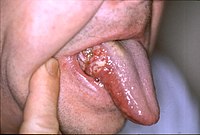
Photo from wikipedia
The primary purpose of this research was to investigate the feasibility and safety of delivering an early supervised physical therapy intervention to women after sentinel lymph node biopsy (SLNB); furthermore,… Click to show full abstract
The primary purpose of this research was to investigate the feasibility and safety of delivering an early supervised physical therapy intervention to women after sentinel lymph node biopsy (SLNB); furthermore, we aimed to provide explorative data on its effects. This was a single-site feasibility study. Pre- and post-evaluation was conducted from baseline to follow-up at 6 months. Primary outcomes were participant recruitment, participant retention, compliance with the intervention, and safety. Secondary outcomes were shoulder range of motion, handgrip strength, upper limb pain and disability, scar recovery, quality of life, and the incidence of axillary web syndrome (AWS) and/or lymphoedema. A total of 43 participants (mean age 55.37 years) completed the trial and the follow-up period. A total of 91% of women who met the inclusion criteria agreed to participate, and the adherence rate was 80%. No adverse events were reported. Incidence of AWS was 9.3%, and there was no incidence of lymphoedema at 6 months. Our results support that this intervention is feasible and safe. The results presented in this study also provide preliminary evidence for the use of a rehabilitation program as a supportive intervention after SLNB, but future research on effectiveness is needed.
Journal Title: International Journal of Environmental Research and Public Health
Year Published: 2020
Link to full text (if available)
Share on Social Media: Sign Up to like & get
recommendations!